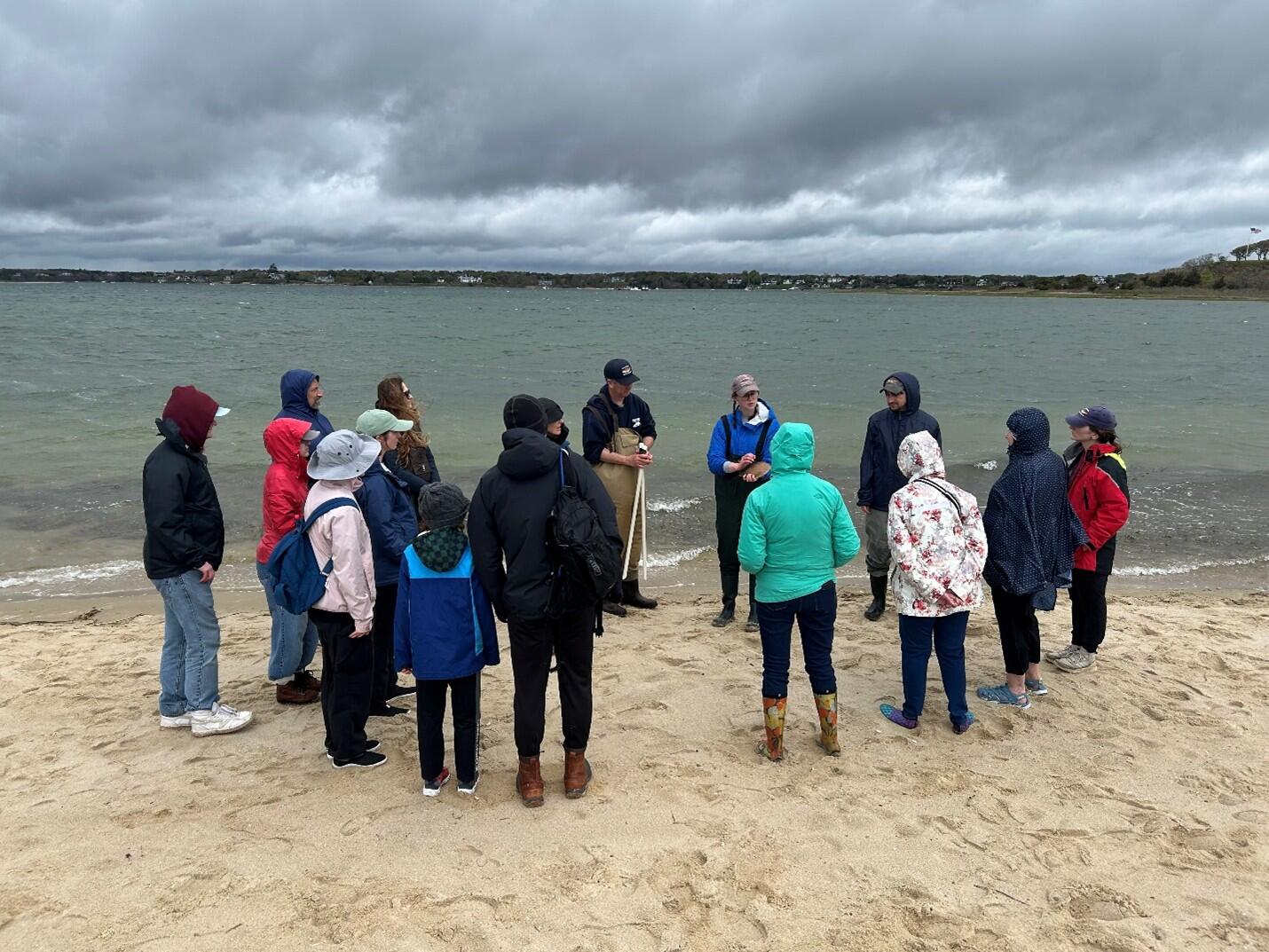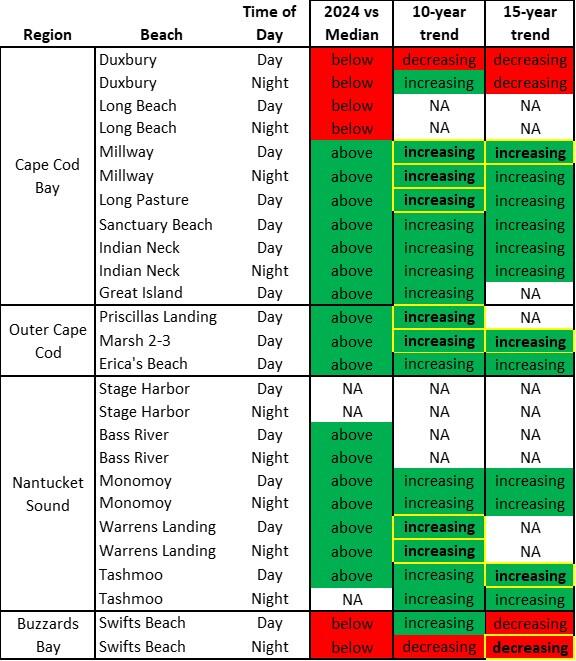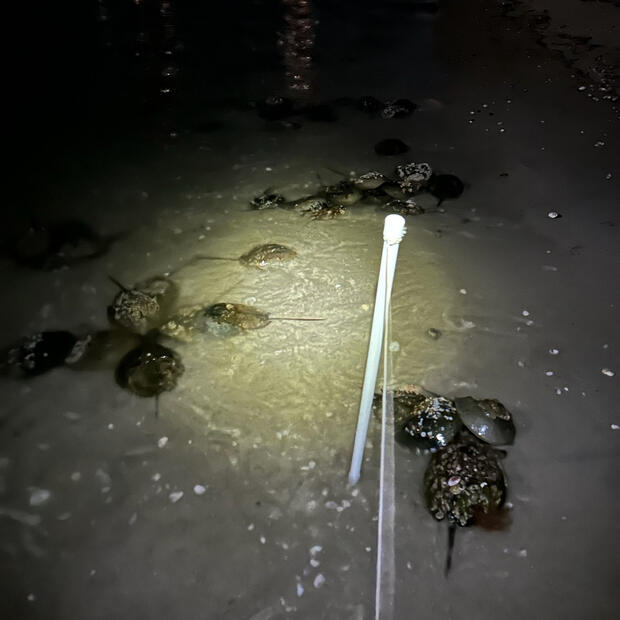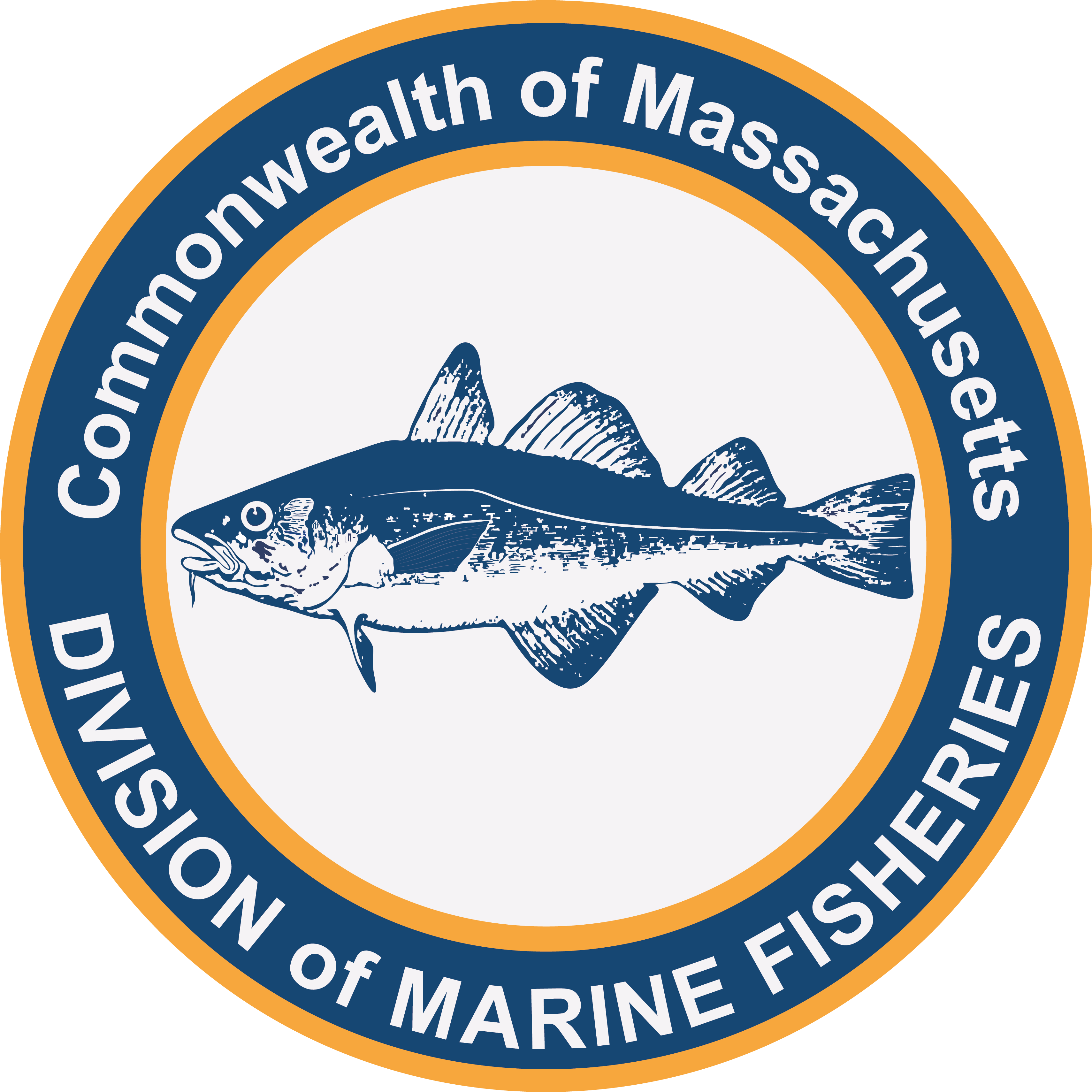- Division of Marine Fisheries

Monitoring programs for horseshoe crabs in Massachusetts are showing promising signs of increasing abundance. 90% of Massachusetts spawning beach surveys show an increasing trend over the last decade. DMF’s annual seine survey has seen above normal numbers of crabs each of the last ten years. The last two coastwide stock assessments conducted by the Atlantic States Marine Fisheries Commission in 2019 and 2024 showed abundance in Massachusetts has been increasing since horseshoe crab management started in 1998, citing data from DMF’s semi-annual trawl survey.
The increase in abundance is likely due in part to lunar closures adopted in 2010 that prohibited the harvest of horseshoe crabs for five-day periods around the new and full moons of May and June. In 2013, this harvest prohibition was extended to include new and full moons during the latter half of April.
The intention of the lunar closures was to allow more crabs to deposit more eggs on Massachusetts beaches. A female horseshoe crab can lay as many as 88,000 eggs, depositing them in several different nests during a given tide, then returning to spawn over the course of multiple days. The lunar closures provided a period where crabs could come up on the beach to spawn and deposit a greater percentage of their eggs before being vulnerable to harvest. It was anticipated that the benefit of these regulations would first be visible on spawning beaches 9–11 years after they took effect, when juveniles resulting from these newly protected spawning periods would reach maturity and return to area beaches to spawn.
In 2024, Massachusetts again increased horseshoe crab spawning protections because of vocal support from the public and conservation groups. These new regulations replaced the lunar closures with an April 15–June 7 harvest prohibition applying to both bait and biomedical harvest. The new regulation results in 54 consecutive days that are closed to horseshoe crab harvest during the spawning season, compared to the 25 discontinuous closed days under the lunar closures. With these additional spawning protections in place, the population numbers should continue to increase. However, the full benefit of the new rule won’t be seen on spawning beaches until 2033–2035.
The new spawning season closure did not prevent the bait and biomedical fisheries from fully utilizing state horseshoe crab quotas in 2024. There are two separate quotas for horseshoe crabs in Massachusetts, one for bait harvest and a different quota for biomedical harvest. Massachusetts fishers with a permit to harvest crabs for use as bait are collectively allowed to catch 140,000 crabs, annually. Fishers with biomedical permits are allowed to collectively harvest 200,000 crabs per year. Crabs caught with a biomedical permit must be returned to the water after the crabs are bled. In 2024, the 140,000-crab bait quota was reached by October 21, despite the delayed start to the season. The biomedical fishery also nearly filled their 200,000-crab quota.
Spawning Beach Surveys
The Massachusetts Horseshoe Crab Spawning Beach Survey started in 2008 and relies heavily on partner organizations (Mass Audubon, North and South Rivers Watershed Association, Southeastern Massachusetts Pine Barrens Alliance, U.S. Fish and Wildlife Service, Maria Mitchell Association, Nantucket Conservation Foundation) and volunteers to conduct surveys. In 2024, 271 different people got involved and collected data for these surveys. The public participation in this survey is a remarkable example of the enthusiasm for horseshoe crabs and provides an opportunity for people to connect with the resource and help gather data through citizen science. The survey is conducted at 16 different beaches, mostly on the Cape and Islands. The same beaches are surveyed each year two days prior, the day of, and two days after the new and full moons of May and June. The survey uses a design similar to what’s been used in Delaware Bay since the 1990s.
In 2024, the number of female crabs observed was above the time series median in 74% of the surveys, meaning most beaches had more female crabs than a “normal” year (see table). The 2024 season was a continuation of positive longer-term trends. Seventy-five percent of surveys are showing positive trends over the last 15 years. All the sites in the Outer Cape Cod region (Pleasant Bay and Nauset Harbor) and Nantucket Sound were above their respective time series median and increasing over the last 10- and 15-year periods. This is particularly important because this is the region of the MA coast where most of the fishery takes place. The biomedical industry has been harvesting from the Outer Cape Cod region (e.g., Pleasant Bay) for 50 years, and 80–85% of the Massachusetts bait harvest comes from Nantucket Sound, annually.
There are only two regions where spawning surveys have decreasing trends: Plymouth/Kingston/Duxbury Bay (PKD Bay) and Buzzards Bay. These areas have very little bait harvest (around 3.5% of the state total) and no biomedical harvest and are in two different regions of the Massachusetts coast. All harvest in these embayments has been by hand. The declines in PKD are very slight and not consistent across time of day or all the beaches in the area. In fact, the ten-year trend on nighttime surveys at Duxbury Beach is increasing slightly. In contrast, at Swifts Beach in Buzzards Bay the nighttime surveys are showing a clear decline; this is the only beach in MA with this clear negative signal. It seems likely that something other than fishing pressure is behind the patterns seen in these two locations.
The 2025 Massachusetts Horseshoe Crab Spawning Survey will continue through June 27. Final survey results won’t be available until later this year. We had unprecedented interest in the survey this year, for which we are grateful. Within 24 hours of soliciting for survey volunteers for the 2025 survey, we had over 500 responses from the public offering to help. Having more volunteers means more of the scheduled surveys are conducted, which decreases uncertainty in the survey results. Results from all Massachusetts horseshoe crab surveys and commercial fishery monitoring are presented annually at the Massachusetts Horseshoe Crab Science Meeting. The meeting is hosted by DMF, usually in March at the DMF office in New Bedford. For more information on the meeting, contact Derek Perry at derek.perry@mass.gov.
Overall, there are positive signs in horseshoe crab populations since the initiation of management plans for this species in 1998. In addition to the ASMFC stock assessment, a recent paper by the International Union for the Conservation of Nature (IUCN) also states that abundance coastwide has been increasing. We believe that the enhanced protections implemented by DMF in 2024 will continue to improve the population of this iconic species in our state waters.
By Derek Perry, Senior Biologist and Horseshoe Crab Specialist


